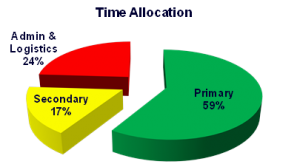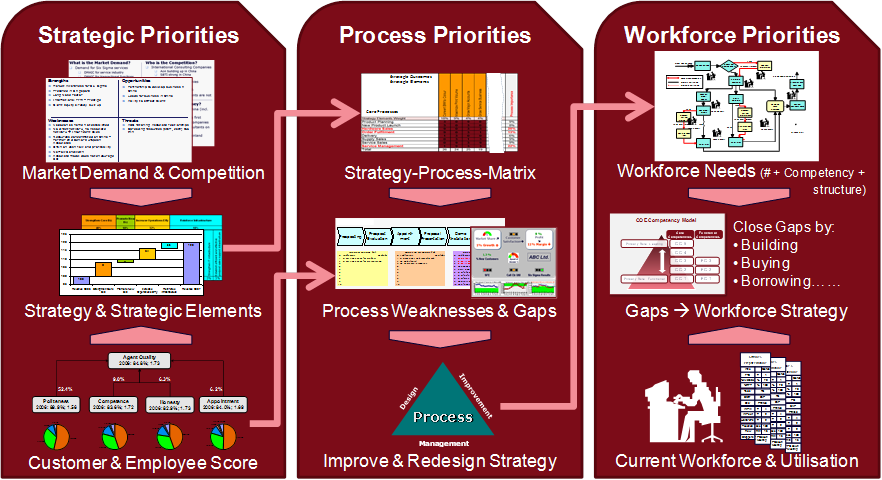Job redesign is about redesigning the tasks in a job so that it fits staff and business needs. For instance, tasks that can be done in isolation can be assigned to a telecommuter, duplicate tasks may be eliminated. One full-time job may become appropriate for two part-timers. Two employees may split a job, but work independently of each other. Looking at the tasks of a job in a new way helps employees to better fit their skills to the tasks to be performed. It may eliminate unnecessary work, permit better use of employees’ skills, enable higher flexibility and more effective work distribution. It attracts and retains quality employees. And it promotes a dual agenda – making work more inspiring and motivating to employees while achieving business goals.
From Pyramid to Barrel-Shape Organisational Structure
Across industries, organisations are constantly reviewing and changing their organisational structure to meet evolving business needs. Instead of a pyramidal shape, more organisations are moving towards building a barrel-shape organisational structure with a large middle group. This is partially due to the fact that companies have reduced recruitment efforts. And it is due to the trend to hire mid-level people – experienced people. They do not need to go through the painful learning phase after their graduation.
Going forward, many of our traditional assumptions about the course of a person’s lifetime career will not hold any longer. Workforce availability and the need for workforce will not match any more. For example, there will be too few “higher” level positions to provide everyone in the workforce with sufficient opportunities for variety, learning or increased compensation – particularly as the new generation cohorts become more eager for frequent change and less willing to remain in one position for extended periods of time.
If you overlay the changing demographic patterns with the changing nature of value creation – the growth in knowledge-based work – our common parameters around time and job design come into question. Most jobs today are still described in terms of a unit of time – a 44-hour workweek or an eight-hour day. In Singapore, the majority of people are now employed in service industries; and already more than half of those are knowledge employees, paid for writing, analysing, advising, counting, designing, researching and countless related functions, including capturing, organising and providing access to knowledge used by others. Time-based jobs make little sense for these employees. Who is to say how long it will take an individual to write a report, conduct an analysis or produce a piece of software?
Consequentially, it does make less and less sense to measure performance on time spent on the job. Jobs need to be designed in a way that measures the output and gives people flexibility in terms of organising their work. Of course, this greatly depends on the jobs being done.
These trends show a high maturity level of workforce in our society. However, these trends need to be accompanied with new methods of human capital management. This article aims to show-case situations on how organisations deal with the new situation. The focus is on of redefining the workplace for the new workforce.
#1 – Job Redesign to Attract the Right People and Retain Them
High turnover in a laboratory setting in our Healthcare sector was partially driven by high workload, some monotone, non-challenging work and inflexible work arrangements. After analysing the Time Allocation for scientists in the lab, it became obvious that highly-trained staff with partially many years of experience in the laboratory environment typically spend only 59% of their time on the jobs they are hired for, the primary analysis work.

Figure 1: Time Utilisation of Highly Qualified Scientists
Another 17% was used for preparatory and support work that can be done by less qualified lab personnel. Even more surprising, a whopping 24% of their time was used for admin and logistics tasks. These tasks could be done by personnel with minimal or without any lab knowledge (Figure 1). This means not only a major waste of highly qualified manpower that is not easy to find in the market and rather expensive. It also means that these people will get frustrated. And, sooner or later they are driven away by the feeling that their skills are not properly used.
Redesigning their jobs to focus on their primary tasks with some involvement in secondary tasks led to a higher job satisfaction, less workload and a better work result. The admin and logistics activities were taken over by a small support team with the long-term plan of outsourcing these doings.
#2 – Job Redesign – Redefine the Work in Terms of Tasks not Time
In a consulting company for instance, there is no need to “go to the office” since consulting mostly happens at the clients’ place. All communication can easily be done via email and phone; and all information is stored in the cloud available from any place at any time. Clients’ emails, faxes and calls are routed to the next available consultant or virtual “office managers”. Since consultants and their office managers can practically do their job most effectively from their home office without the need to waste time in car, MRT or Bus, their tasks can be done any time over the day.
Reorganising the non-customer facing days means, shopping is best – and takes much less time for queuing at car parks, counters and cashiers – during “normal” office hours. Hence, these members of a consulting company are able to free up time by working against the usual cycle, spend time with their kids if needed and pick up their clients’ calls even after office hours happily. An eight-to-five work arrangement is a great hurdle for their work and lifestyle.
The task of measuring their work result instead of their office time is one of the challenges, modern competency-based, results-oriented performance management systems deal with easily.
#3 – Job Redesign – Defining Workforce Priorities
Workforce planning needs to be started at a process level by assigning number of staff and competency required for each step. Studying existing process steps and benchmarking them against the best serve as a guideline for deriving workforce needs. Data gathering can be done during open interviews, structured focus group sessions or even through time study on the process (Gemba Study).
Whereas manufacturing processes are highly structured, regulated and enforced by machines, service processes are typically less stringent resulting in somehow more variation in processing time for certain process steps. Time studies are necessary for processes with rather large variation. A robust set of processing time data is a key necessity for the integrity of the overall result. Moreover, even if customer demand changes in future and processes get amended, the smallest unit, the process step changes at the least degree. Hence, this information will be useful for future planning activities, too.

Figure 2: Time Study and Resource Gap Analysis of one Process
After having collected all workforce needs for existing processes, workforce gap analysis (Figure 2) as well as workforce projection can be performed. Using software to build the process-workforce-database supports future workforce planning activities. The output of a workforce plan will be translated into a workforce strategy, which in turn defines HR strategy and HR plan.
Workforce analysis without accompanying process analysis could lead to having the right workforce for the wrong process. Therefore, the logical steps for strategic workforce planning are: understanding business priorities, translating them into process priorities and deriving workforce priorities out of both (Figure 3).
#4 – Re-Framing Mind-set, Re-Defining Jobs

Figure 3: COE Workforce Planning Process
Difficulties in attracting the right candidates and retaining them have challenged a local edutainment setup to rethink the job roles and the working condition for the science communicators that have existed for more than 10 years. The feedback from focus groups and the lifestyle surveys shown that, amongst other factors, working on every weekend and all public holidays was demotivating employees as they struggled to keep pace with their life and social events.
All this was making retention of employees a key issue. Another contributing factor to the low attraction and high turnover was the limiting job scope that became monotonous after a while. There were two different groups of employees with one team performing demonstrations and conducting workshops and the other carrying out interaction on the ground with the visitors. This structure was a result of hiring more resources to carry out the increased workload due to expanded business operating space and also to cope with the retention issue.
The job duties were updated and the processes were refreshed. One condition that had not changed was that the management would still require the two groups of employees to work on weekends and public holidays, to cater for the customers’ needs. It would seem then the only solution was to increase the headcount again thus increasing manpower cost. Job redesign no doubt is about reviewing the current scope of work but finding the best ways to do things is also a key element of job redesign. The situation has challenged the management to rethink the ways things have been done, review the resource planning process and analysis the customers profile and data.
Reframing of the situation allowed them to see that the two different groups of employees who have the same qualifications were capable to deliver all the job duties and this resource could be pooled for resource optimisation. Instead of having 5 employees in each team delivering on a fixed set of job scope, the resource pool had expanded to 10 employees sharing the whole spectrum of work making their job more interesting and motivating.
With this pool of resource, work roster could be implemented and the employees are now working only 1 weekend every 2 months instead of having to work on every weekend. This job redesign and new resource management have allowed for the development of career pathways for the employees and higher employee engagement as they now are given time to participate in company’s projects. Retention rate of the high potential employees has increased by 50% since the revised scheme has been implemented.
Conclusion
In the past, Job Redesign used to be a one-time affair performed by forward-thinking organisations to keep up with long-term changes in an organisation. Now, changes are required and happen more frequently. Hence, Job Redesign needs to happen as often in order to keep track. This modern approach needs to be part of every progressive HR leader’s toolbox.
Job-Redesign can only be done effectively in partnership with business leaders and line managers and it requires understanding their processes along with competencies needed. This gives our open-minded HR professionals an opportunity to demonstrate the contributions they can make to the prosperity of the entire firm, ensuring that they will be key participants in the flattened, dynamic, networked and global corporations of the future.

